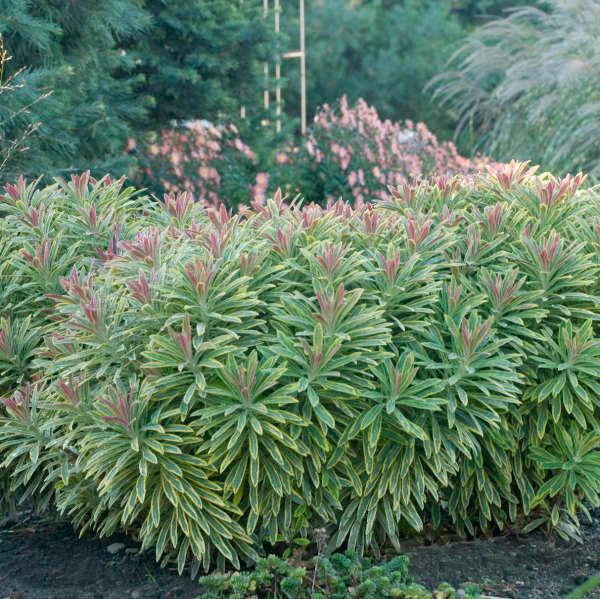With its vibrant, variegated foliage, Euphorbia x martinii ‘Ascot Rainbow’ makes a striking statement in any garden This eye-catching perennial looks beautiful when paired with the right companion plants.
Certain plant pairings can enhance Euphorbia’s colors, complement its texture, and share its growing needs. Careful companion planting also increases biodiversity.
Here are 10 ideal Euphorbia Ascot Rainbow companion plants to incorporate for a thriving. aesthetically pleasing garden
1. Lavender
The cool purple hues of Lavender nicely complement the hot pinks and greens of Euphorbia Ascot Rainbow. As drought-tolerant Mediterranean natives, both plants share similar soil and watering preferences in full sun.
Lavender’s compact growth habit provides nice contrast to the mounded form of Euphorbia. The aromatic herb also attracts pollinators while repelling pests like moths and mosquitoes.
Try pairing Euphorbia with English Lavender (Lavandula angustifolia) for waves of spring-summer blooms or French Lavender (Lavandula stoechas) for longer winter interest.
2. Penstemon
Penstemons come in a diverse array of heights, colors, and bloom times, allowing ample options for pairing with Euphorbia Ascot Rainbow. These perennials appreciate full sun and well-drained soil just like Euphorbia.
Low-growing varieties like Penstemon pinifolius offer nice textural contrast and bring pollinators. Taller types like Penstemon digitalis can provide a colorful vertical backdrop.
3. Catmint
Catmint (Nepeta) combines wonderfully with Euphorbia Ascot Rainbow. Its dusty blue or white flowers and fragrant gray-green foliage mesh nicely with Euphorbia’s vibrant colors.
As a drought-tolerant perennial, Catmint thrives in hot, dry conditions. The billowy mounds help soften and complement Euphorbia’s rounded form. Catmint’s cascading habit also makes an attractive border or edge.
4. Russian Sage
Russian Sage (Perovskia) shares Euphorbia Ascot Rainbow’s appreciation for full sun and dry conditions. The groundcover’s silvery-blue foliage and airy purple flower spires pop against Euphorbia’s variegated leaves.
Try combining Euphorbia with Perovskia ‘Little Spire’ for a more compact, manageable clump or P. atriplicifolia for billowy 3-4 foot spires.
5. Blanket Flower
A standout native wildflower, Blanket Flower (Gaillardia) blooms prolifically in shades of red, orange, and yellow from early summer into fall. The daisy-like flowers contrast beautifully with Euphorbia Ascot Rainbow’s colorful foliage.
As a hardy perennial, Blanket Flower thrives in dry, lean soils and full sun exposure, making it an ideal erosion control partner. Try G. aristata for a long bloom period or G. x grandiflora for extra large, vibrant flowers.
6. Sedum
Another drought-tolerant perennial, Sedum comes in a wide variety of forms and colors. The succulent foliage and clusters of tiny starry blooms pair exquisitely with Euphorbia Ascot Rainbow.
Low carpet varieties like Sedum spurium offer evergreen groundcover. Upright types like Sedum Autumn Joy lend height and structure. All sedums thrive in hot, dry conditions and poor soils.
7. Coreopsis
Coreopsis delivers an abundance of sunny yellow or red daisy blooms contrasting beautifully with Euphorbia Ascot Rainbow’s hot pink hues. The compact, mounding perennials share an appreciation for warm temperatures and fast-draining soil.
Try combination like C. grandiflora ‘Early Sunrise’ and C. verticillata ‘Moonbeam’ for waves of color. Coreopsis also attracts beneficial pollinators to the garden.
8. Yarrow
Yarrow’s airy flattened flower clusters in shades of white, yellow, pink, or red provide pleasing contrast against the colorful rounded form of Euphorbia Ascot Rainbow. Both plants thrive in lean, dry soils.
Fern-like leaves and strong scents that repel pests like mosquitoes and flies make yarrow a valuable companion. Good choices include Achillea millefolium and Achillea ‘Moonshine’.
9. Salvia
Salvias come in a huge range of sizes, colors, and forms for versatile pairing with Euphorbia Ascot Rainbow. As drought-tolerant perennials, Salvias and Euphorbia share cultural requirements for fast-draining soils and hot conditions.
Try combining Euphorbia with compact Salvia nemorosa ‘May Night’ or elegant Salvia argentea for contrasting colors, textures, and form.
10. Daylily
Daylilies (Hemerocallis) bloom profusely in an array of shades that pop against variegated Euphorbia Ascot Rainbow. These perennials appreciate the same growing conditions of full sun and medium to dry soil.
Early, mid, and late season daylilies can supply color from spring through fall. Try combining a range of sizes and colors for endless combinations, like yellow H. ‘Stella de Oro’ and wine-red H. ‘Cranberry Baby’.
By incorporating companion plants with shared growing needs and contrasting colors and textures, you can create a stunning, low maintenance garden that highlights Euphorbia Ascot Rainbow as a focal point.
When pairing companions, avoid aggressive spreaders that could overtake the Euphorbia. Also steer clear of plants with very different cultural requirements like heavy watering needs or preference for afternoon shade.
With thoughtful selection of complementary perennials, you can design a garden that keeps your eye-catching Euphorbia Ascot Rainbow thriving for years to come!
Euphorbia ‘Ascot Rainbow’ (Spurge) // Very USEFUL perennial with UNIQUE foliage and flowers
FAQ
What pairs well with Ascot Rainbow Euphorbia?
What should I plant next to Euphorbia?
Does Euphorbia ascot rainbow like sun or shade?
How tall does Euphorbia ascot rainbow grow?

